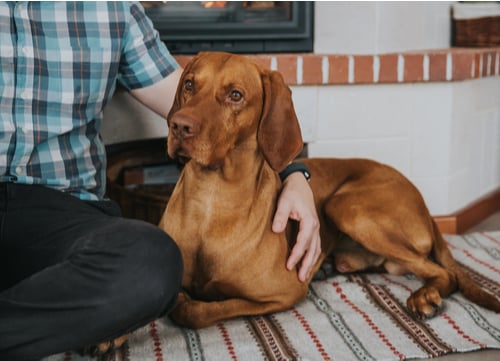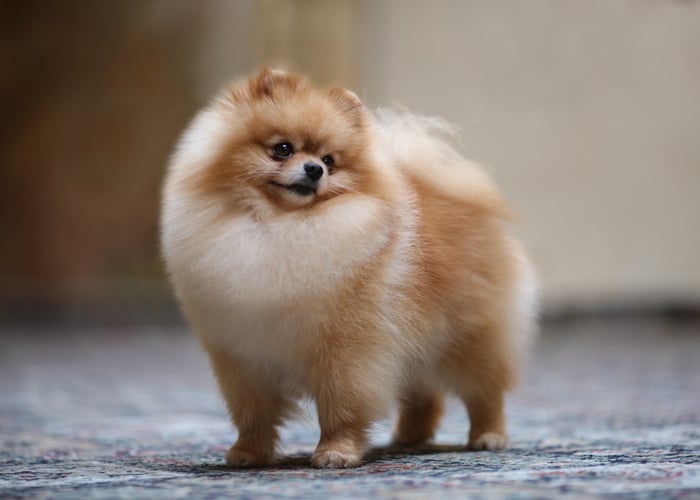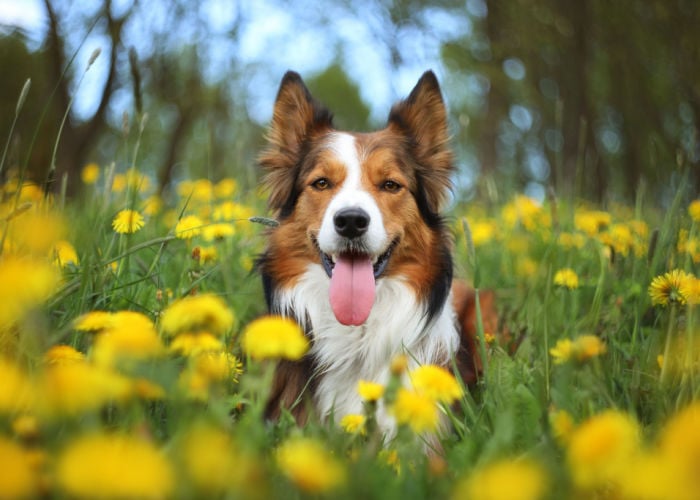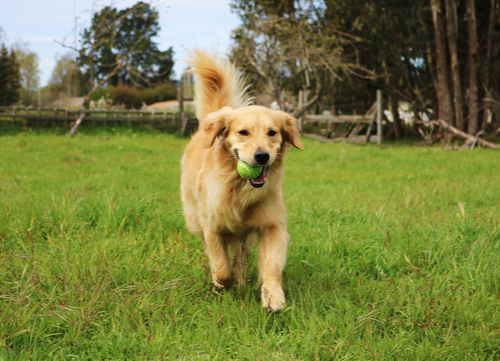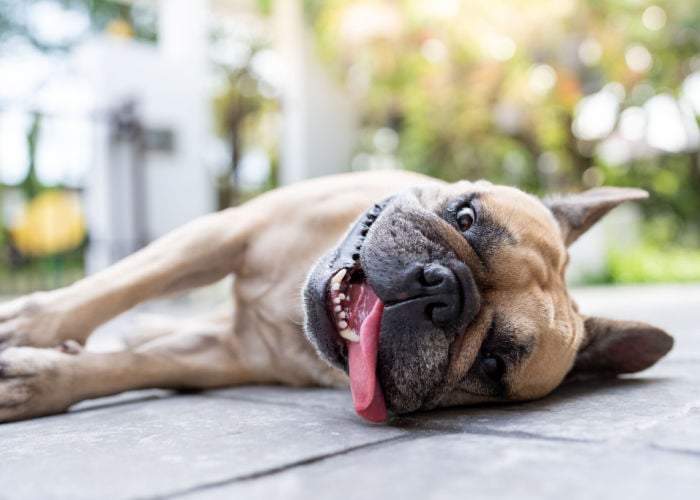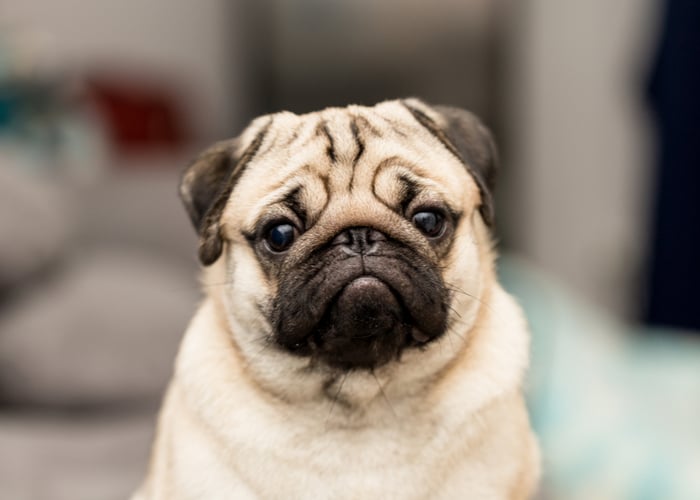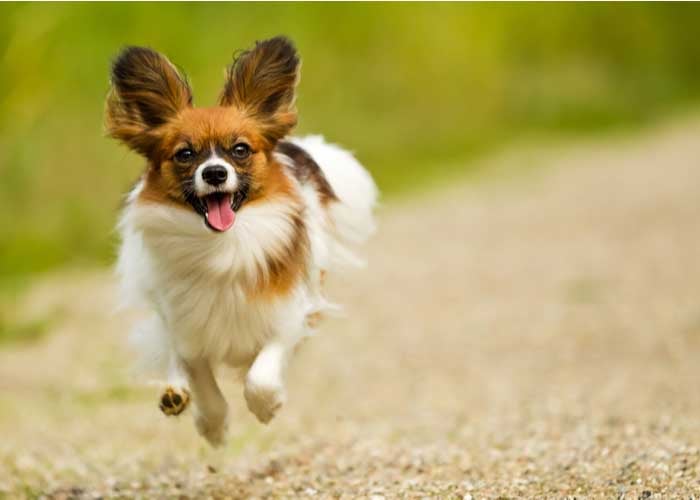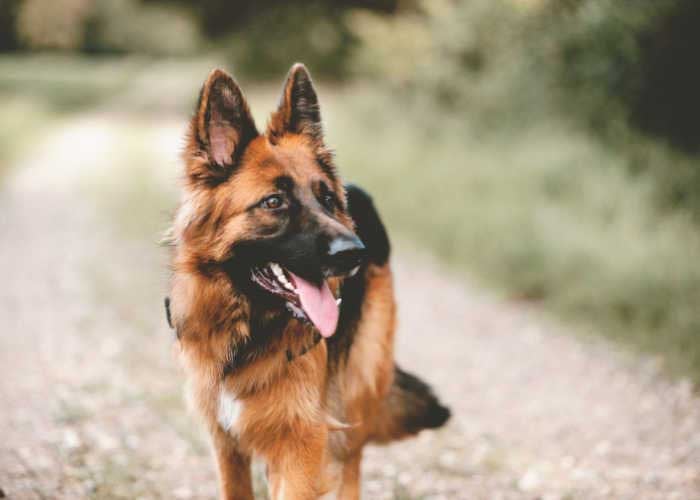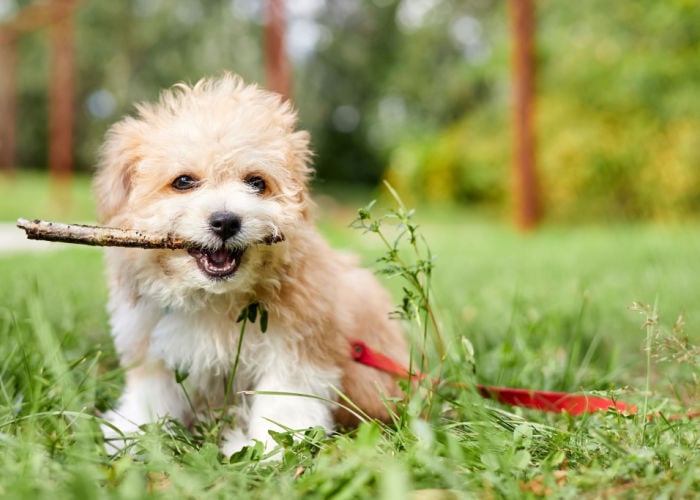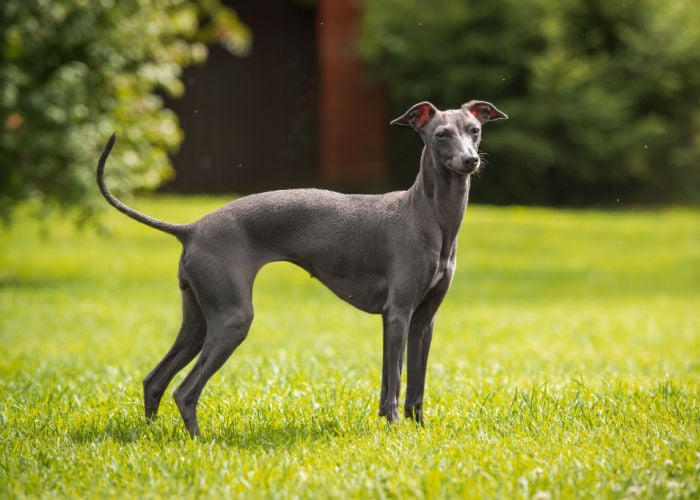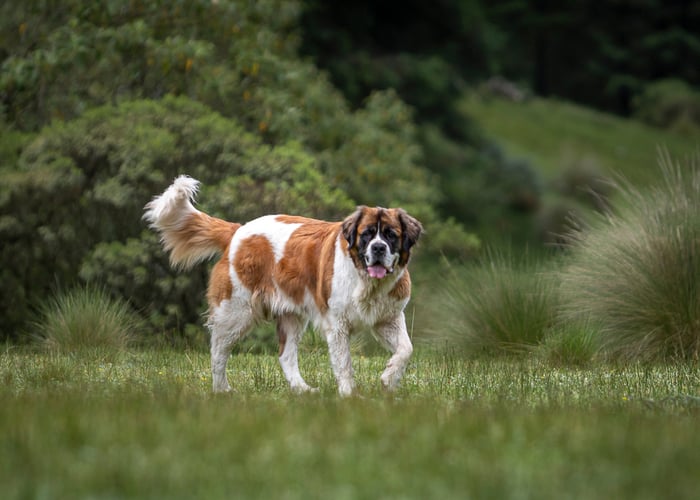
Table of Contents
Picture this: You are trying to sneak into the kitchen for some midnight snack without waking anyone up.
Suddenly, you felt a pair of eyes follow you so closely, like a shadow.
Yes, like in horror movies!
Then you look slowly and see your pup following you like a stealthy ninja.
You might think you’re successful at sneaking, but if your dog is one step ahead of you—literally and figuratively…
Surprise! You have a “Velcro dog.”
In this article, we will discuss 15 Velcro dog breeds and explain why they are predisposed to being extra clingy.
We'll also give out tips towards the end on how to “un-Velcro” your clingy pooch.
See here if your dog's breed made it to this list:
- Vizsla
- Chihuahua
- Pomeranian
- Border Collie
- Doberman Pinscher
- Golden Retriever
- French Bulldog
- Pug
- Papillon
- English Bulldog
- Labrador Retriever
- German Shepherd
- Maltese
- Italian Greyhound
- Saint Bernard
But First… What is a Velcro Dog?
A dog’s love knows no bounds. No wonder they are labeled “man’s best friend.”
If you find their behavior too clingy to the point where you almost trip from them following you all around, then you have a Velcro dog.
Velcro, as in the fabric fasteners they use in fashion and arts.
And why Velcro, you ask? Because those two pieces of fabric always stick together, just like your pup to you.
A Velcro dog is a term used to characterize a dog who is overly clingy and attached to their owners.
Velcro dogs take loyalty to a whole different level—the adorable stalker level.
Dogs are innately pack animals. It means that they opt to socialize or live within a group.
Since they live a more domestic life today, they will likely be closer to their owner’s side.
After all, since you feed and give them instructions, they now consider you your pack leader.
Although showing affection is part of a dog’s normal behavior, some dogs are just too clingy.
What Behaviors Suggest that My Dog is a Velcro Dog?
If you are in the process of adopting a dog, a velcro dog will approach you quickly. They will show no hesitation in following you around.
Typically, dogs take more time to warm up to a new fur parent.
Velcro dogs, on the other hand, will be more adjusted from the get-go.
Here are other common behaviors of a Velcro dog:
- They follow you around very closely and refuse to leave you alone.
- They become anxious when left alone and thus do excessive barking or whining.
- They exhibit attention-seeking actions like pawing, licking, or jumping on you.
- They are showing signs of jealousy towards other pets or other people.
If you notice these behaviors in your pup, it is important to know that this behavior can be a breed-specific thing or a learned behavior from lack of training or too much positive reinforcement.
First, we tackle the breed-specific explanation for a dog’s clingy behavior.
Here are 15 Velcro Dog Breeds and their characteristics.
15 Velcro Dog Breeds
that you should meet!
1. Vizsla
They are famous for being the ultimate Velcro dog breed.
Vizslas are also the first ones to be called a Velcro dog!
The American Kennel Club calls this breed “energetic, affectionate, and gentle”.
Aside from being built for long days in the field, this Hungarian breed is a big baby.
Vizslas thrive on companionship. They will follow you around and eagerly take part in your daily activities.
Vizslas are active dogs, so if they are isolated for too long, they can be quite destructive.
After all, they are infamous for chewing things when they are bored.
2. Chihuahua
Chihuahuas are a Mexican toy dog breed. The Chihuahua is considered the smallest dog breed in the world.
Since they're so tiny, we can't blame their fur parents for always bringing them around!
Despite being small, they have big personality. They require a lot of attention.
They also find comfort in snuggling up in your lap or being anywhere near you.
3. Pomeranian
Pomeranians have a reputation for being bossy and vivacious.
Despite their size, they do have big personality.
They also love being the center of attention, and since they're so little, they are used to being carried around wherever their owners go.
When left alone, they tend to be attached to their owners and develop separation anxiety.
It's good that Pomeranians are also smart and easy to train, so their clingy behavior can be easily unlearned.
4. Border Collie
Border Collies are known to be the most intelligent dog breed.
Border Collies lead an active lifestyle, not just physically but mentally.
It's not enough to walk them around the neighborhood… they need actual tasks!
Mental stimulation is a big deal for them. Their owners must spend much time mentally active to keep them happy and healthy.
That is why they are prone to clinginess as a Velcro dog breed.
Border Collies will get bored and follow you all around, sit next to you, and whine if there is a lifestyle mismatch.
They need constant physical and mental stimulation.
5. Doberman Pinscher
Doberman Pinschers have a reputation for being scary and dangerous.
But they can also be gentle, loyal, and loving dogs, especially to their owners.
Doberman Pinschers got their reputation from being protective of their owners. Since it is a family dog, it does well with being around the company of its family.
It is safe to say that although they can appear “dangerous,” they are a softie for their family.
Since Dobermans are active, they do not thrive in isolation and confinement.
So if they aren't walking or running, their owners must spend time playing with them.
6. Golden Retriever
Golden Retrievers are great family dogs.
These big babies love being around people, especially children.
They also love being the center of attention, whether from other animals or people.
Golden Retrievers can be active as long as they get to be included in family activities and adventures.
They do not want to be left alone. These dogs are best for families where someone can stay with them at home most days.
You should get a Golden Retriever if you're looking for a dog that you can train for simple jobs such as waking the kids in the morning.
They love having a responsibility because they aim to please their owners as much as possible.
7. French Bulldog
In 2022, the French Bulldog was ranked America's most popular dog breed.
French Bulldogs are smart and easy-going, which makes them good companion dogs.
They also love to be held cuddled and won't say no to sitting on your lap anytime they can!
Since they are indoor lap dogs, they are content lounging around the house as long as they get near their owners.
8. Pug
Pugs are made to be family dogs.
They are playful but depend on their owner's companionship because they do not live an extremely active lifestyle.
So, leaving them alone for a long time is not a good option. Isolation will cause depression and separation anxiety.
9. Papillon
The Papillon, also nicknamed the “Butterfly Dog,” has a radiant personality.
Papillons are eager to please their owners and those they bond with.
They are home buddies and are content to spend quality time with you. They are happy even with just sleeping beside you.
Papillons always try to be as close to where their owner is. They are affectionate and clingy.
That being said, these small dogs don't do well with being left alone, as they get sad and anxious.

10. English Bulldog
English Bulldogs are a great companion if you live a more relaxed lifestyle.
Bulldogs are friendly and get along with children and other animals. Overall, they love to be around people.
However, English Bulldogs also tend to be clingy and overly attached.
They love physical contact and enjoy snuggling on the couch or lying on your lap.
When left alone for long periods, they tend to behave violently.
11. Labrador Retriever
For over three decades, the Labrador Retriever has been the most popular dog in America.
Labradors are clingy and active, so they will go wherever you want to. You can bring them on your errands or your trips and adventures.
Anywhere as long as they get to feel included.
Since they are a family dog, Labrador Retrievers do not do well with being alone. They want to be with their family all the time.
So, they will try to escape if left unattended for a long time.
Boredom will also make them find their source of entertainment.
And guess what? They will chew on your belongings or even make a hole in the wall!
12. German Shepherd
According to the American Kennel Club, the German Shepherd is the world's 4th most popular dog breed.
They are smart and easy to train, so aside from being family dogs, they are used as working dogs.
German Shepherds are loyal and courageous. They are affectionate and protective of their home.
Because they crave an active lifestyle, they should not be alone for too long.
Otherwise, they also get destructive and chew on things when lonely, bored, or frustrated.
13. Maltese
A Maltese is a great companion dog and friend.
They are very affectionate and highly devoted to their owner and family.
This attachment comes with some consequences. A Maltese might only be for you if you are prepared to give your dog lots of attention and time.
For one, leaving your Maltese alone often for too long (several hours) can make the dog anxious and stressed.
Maltese also gets super attached to you to the point that they cannot form a bond with other pets or people.
This happens especially when they get used to being a lone pet for a long time. But, if you socialize them often, you should not encounter challenges.
14. Italian Greyhound
Italian Greyhounds were a favorite among noblewomen during the Middle Ages.
Need I say more? They are generally playful, loyal, lovable, and friendly!
Italian Greyhounds are also always eager to please you. They are good watchdogs and do not require extraneous activities to stay fit and active.
15. Saint Bernard
Saint Bernards, popular family dogs, love being around humans.
They may be giants physically, but they are just babies through and through!
They could be intimidating, but don't be fooled because they are full of warmth and affection.
Their size will not stop them from wanting some cuddles.
And since they are a giant dog breed, they're not meant to be a lap dog, but they'll take the spot anyway!
A Velcro Dog is Made, Not Born
Why some dogs are more clingy than others
Now we have listed some velcro dog breeds and why they are predisposed to being more clingy than usual.
But did you know that aside from being breed-specific, being a velcro dog is also a learned behavior?
This might be a hard pill to swallow, but a Velcro dog’s behavior is shaped.
Some owners unknowingly encourage their pups to be extra clingy.
Yes, your pup adopted these needy behaviors from you.
We could look at Velcro dog breeds to identify which dogs tend to become more clingy.
But, it is as important to acknowledge our habits as fur parents that foster velcro dog behavior.
Below are some dog owner habits that might be reinforcing Velcro dog behavior.
Too Much Positive Reinforcement
If you frequently express your love to your dog by offering them treats whenever they approach you, it will condition them to expect praise and rewards whenever they come near you.
Too much positive reinforcement is not good.
And the more you reward a certain behavior, the more it will continue.
Co-sleeping
Another habit that creates a Velcro dog is co-sleeping.
If your dog is sleeping in your bed, this creates a strong feeling of dependency.
They will constantly make them feel like they need to be near you all the time.
Lack of Socialization
Lack of socialization with other animals or people will also make your dog extra clingy.
If you take them with you wherever you go, they will not get enough time to form a bond with other people or animals but you.
Stress or Anxiety
Your pup trusts you more than anyone.
There are multiple reasons why dogs can be stressed. Some examples are sudden changes in routine, being in an unfamiliar setting, or isolation.
Your dog might need extra affection because he is looking for stability and sees you as a guide to help him navigate unpleasant emotions.
Health Issues
If your dog feels sick and vulnerable, they tend to stay closer to you for some sense of familiarity and security.
This is common in senior dogs whose vision or hearing are not as sharp as they used to be.
Your dog will need you as they navigate this change and, in turn, cling to you more.
It is also a good practice to keep your vets informed so that they can check if there's a health issue to be worried about.
Trauma
Dogs who have been abandoned before are most likely to become Velcro dogs.
This past trauma, like the fear of abandonment, will cause your dog to be more needy of your affection and validation.
Separation Anxiety Vs. Velcro Dog Behavior
Too much clinginess is not for everyone.
Especially for dog owners, some prefer the extra affection they receive from their dogs, while others do not.
For the fur parents who wish to lessen this behavior, the first step is to be able to distinguish separation anxiety from velcro dog symptoms.
It is separation anxiety when:
- Your pup follows you everywhere you go.
- If they get anxious and stressed whenever you leave or attempt to.
- They exhibit destructive behaviors like chewing on things when left alone.
- When alone, they try to escape the house to look for you.
It is Velcro Dog behavior when:
- Your pup follows you around.
- If they keep their eyes on you all the time.
- When they get triggered with your every move. This means that they pay attention to your every action.
- They remain alert while watching you, always trying to anticipate your next move.
- They want to stay physically close to you at all times.
Distinguishing these behaviors will let you know that you have a Velcro dog. And from here on, you can determine the right course of action.
How to “Un-Velcro” Your Dog: 4 Tips to Reduce Their Clinginess
But how do I make my dog less clingy?
Remember that your pup sees you as their pack leader. So, you should be the one who can give them instructions on how to behave.
Besides, dogs will do better in an environment where rules are enforced and boundaries are upheld.
Here are 5 Helpful tips to reduce your dog’s clinginess.
1. Enforce Social Distancing
“Stay!” is one of the best instructions or commands your dogs need to learn.
Of course, you can opt to create your own word command that will work for your dog.
Especially for Velcro dogs who follow you constantly, you must teach them to respond to ‘stay’ and reward them for being still.
If you are tripping as your dog follows you, you can simply create distance from them.
Once you stand up, say the magic word and slowly move away.
Start small and increase the distance over time. Of course, don’t forget to improve the praise and treatment along with the distance!
2. Do Not React
Velcro dogs are alert to your every move.
They can predict some triggers to your behavior. For example, standing up while carrying dishes means going to the kitchen.
Or, if you put your shoes on, that means you’re going outside.
It would be best to observe which of your actions trigger your dog and desensitize them.
Practice repeating these triggers without going anywhere or without anything happening.
In short, tie your shoes but do not go out. Do this multiple times or until your dog stops reacting to it.
If you do this consistently, the triggers will lose meaning, and your dog will eventually unlearn it.
3. Energy Conversion
If your dog has the energy to follow you all around the house and up and down the stairs, they could use that energy elsewhere.
Once a dog is properly tired from some exercise or play time, there is a good chance they won’t have the energy to stalk your every step.
You don’t need that kind of energy; they must spend it elsewhere.
Be it a walk around the neighborhood, a trip to the dog park, or some fetch in the backyard, really do anything fun!
4. Brain Exercises: Keeping their Minds Stimulated
Mental stimulation is just as important as physical exercise.
You must constantly challenge your dog to keep their mind active and working.
You can try problem-solving challenges, teach them new tricks, or play games.
Fetch, tug, obstacle courses, scatter feeding, and puzzle toys are some other things to keep your dog mentally stimulated.
Maintaining a busy or active brain will keep your dog away from boredom.
Because if they have nothing else to do, then they will definitely just follow you around.
Keep them mentally occupied!
Velcro Dog Breeds: Before You Go…
To conclude, whether it is nature or nurture, the term “velcro dog” describes a pup that is overly attached to its owners.
Sure, certain dog breeds are predisposed to be more clingy and needy than others.
But, it is still important to acknowledge that our actions as fur parents create an environment where velcro dog behaviors are reinforced and tolerated.
In this article, we have provided some strategies that will help you help your dog unlearn these behaviors.
Recognize the factors contributing to your pup’s clinginess and take proactive measures to address them.
Doing so allows you to balance being loving and affectionate towards your dog while still having some of your personal space.
Remember that every dog is unique, and a little training goes a long way.
To read more about dog training tips, check out these articles below!


